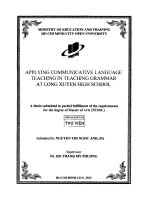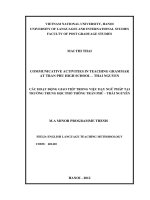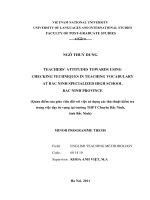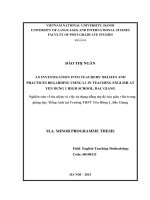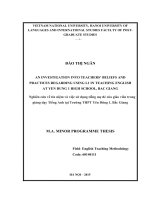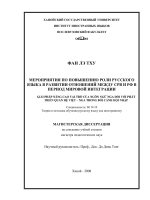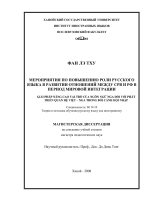Research proposal EFL Teachers’ Barriers in Teaching English at Long Xuyen High School.
Bạn đang xem bản rút gọn của tài liệu. Xem và tải ngay bản đầy đủ của tài liệu tại đây (249.42 KB, 24 trang )
<span class="text_page_counter">Trang 1</span><div class="page_container" data-page="1">
<b>VIETNAM NATIONAL UNIVERSITY HCMCAN GIANG UNIVERSITY</b>
<b>RESEARCH PROPOSAL</b>
<b>TITLE: EFL Teachers’ Barriers in Teaching English at Long Xuyen High School.</b>
<b>SUBJECT: Educational Research</b>
<b> STUDENTS: Lê Thị Ngọc Ánh- DTA197364</b>
Hà Quách Tấn Đạt- DTA197362
Lâm Mai Tường Vi- DTA197410
Nguyễn Thị Tường Vy- DTA197353
<b> CLASS: DH20TA1</b>
</div><span class="text_page_counter">Trang 2</span><div class="page_container" data-page="2"><b>TABLE OF CONTENTS</b>
<b>Chapter I: Introduction...4</b>
<b>1. Background...4</b>
<b>2. The purpose of the research...6</b>
<b>3. The research question...6</b>
<b>4. The significance of the research...6</b>
<b>5. Key term...7</b>
<b>Chapter 2: Literature Review...8</b>
<b>1. Teaching English as a foreign language in Vietnam...8</b>
<b>2. Previous research findings...8</b>
<i>2.1 The difficulties of teaching English language: The relationship between research andteaching...8</i>
<i>2.2. Problems of teaching and learning spoken English in Sudan...9</i>
<i>2.3. Difficulties in teaching English for specific purposes: Empirical study at VietnamUniversities...9</i>
<i>2.4. Difficulties that English teachers encounter while teaching listening comprehensionand their attitudes towards them...10</i>
<i>2.5. Challenges in teaching English faced by English teachers in Indonesia...11</i>
<b>3. Common difficulties in teaching English...11</b>
</div><span class="text_page_counter">Trang 4</span><div class="page_container" data-page="4"><b>Chapter I: Introduction</b>
<b>1. Background</b>
Language is utilized by everyone to convey feelings, views, ideas, and objectives. Communication between individuals is facilitated by language. According to Brown (2006), language is a set of arbitrary conventionalized spoken, written, or gestural symbols that allow members of a particular group to understand one another. This indicates that language is a kind of communication. Alternatively said, language is a form of inter-communal communication. Information exchange is an important aspect of interpersonal engagement. To communicate, everyone utilizes language. Without language, humans are unable to communicate verbally or give information to others. To interact with other people, language should be essential. Obtaining information allows people to expand their understanding. Language and human behavior are closely related to one another. It indicates that language is employed to communicate how we feel in order to gather information throughout daily tasks.
In every discussion activity or discourse, everyone requires language to communicate their thoughts, feelings, and emotions. On the other hand, written language is employed in public information like books, journals, magazines, research…
There are many kinds of language that are used to communicate. One of them is English. According to Syamsinar Mappiasse & Sihes (2014), English has become the most spoken language in the world of today. Thus, the ability in using English is very important for everyone. As stated by Lauder (2008), English is being used for following technological and scientific improvements and also for better job opportunities. That shows that English plays an important role in many aspects in our life, such as in education, business, politic… As a result, both developed and developing nations should be aware that learning and mastering English is crucial.
In nations where English is not the native tongue, teaching English has become a significant concern. As a result, learning a second language can be challenging for students because they are unable to use their new language in everyday settings and are instead expected to learn grammar
</div><span class="text_page_counter">Trang 5</span><div class="page_container" data-page="5">rules from textbooks rather than in a practical setting. Because of the numerous problems they face and the frequent questions they have regarding the most effective teaching methods, teachers should always seek out practical alternatives to ease the hardships of teaching the English language. EFL (English as a foreign language) teachers work with non-native English speakers and help them practice their language skills by instructing them on reading, writing and converse effectively in English. Many EFL teachers work in public education, helping children of all ages learn English. (Wikimedia Foundation)
Nowadays, having English as a second language is more of a benefit than a commodity. It is studied and used all over the world as an official language, a second language, or a foreign language, and it is developing quickly as a global language. It is unlikely that what people or kids learn in school or at home qualifies as the language spoken by native speakers. It is our intention to show that students at Long Xuyen High School do not receive regular, informal speaking practice, and to offer solutions for addressing this issue. This is the problem encountered by Long Xuyen High School students who study a foreign language mostly through books and have little to no interaction with native speakers when they are thrust into real-world settings where they must deal with native speakers. The challenges students face span from linguistic and lexical gaps to grammar and communication problems, to cultural ones. The variety that students encounter is as varied as the spread of English and keeps evolving daily. In this regard, Crystal (1997) acknowledged that even the best teaching English, which is used far more than any other during a typical speaking lifespan, is not without its flaws.
In Vietnam, there has been little success with teaching English as a foreign language. Previous studies have demonstrated that there are serious issues with the teaching of English as a foreign language in the setting of Vietnam, including low teacher competency, low student motivation, and low English proficiency success among students. The standing and success of English as a foreign language are significantly influenced by its teaching. Because English is not utilized to teach language in the classroom or as a means of communication during social interactions, students often only encounter a tiny quantity of English within and outside the classroom. The burden of ensuring that students study English in a friendly environment and bringing effective language learning into the classroom falls squarely on English teachers as a result of this
</div><span class="text_page_counter">Trang 6</span><div class="page_container" data-page="6">absence. Thus, teaching English as a foreign language requires a variety of complicated skills in addition to teachers' language proficiency and teaching abilities (Van, 2018).
Based on the researcher’s experiences during observation and teaching practice in Vietnam, the researcher identified a few issues and challenges that frequently arise, particularly for the teachers, during the teaching and learning process in the classroom. The first is that the kids did not comprehend the teacher's topic. The second is that pupils don't care about learning, especially when it comes to conversational speaking training and their pronunciation is still poor. In this situation, English teachers must choose some effective teaching methods and come up with new ways for students and teachers to communicate their thoughts during the teaching and learning process in the classroom.
Based on the above explanation, we recognize the necessity of the topic and the motivation to carry out a qualitative research about “EFL Teacher’s Barriers in Teaching English at Long Xuyen High School”. Though there are a substantial number of studies in literature carried out to reveal the difficult of English teaching experienced by teachers at Long Xuyen High School, few of them provides a deep understanding of this phenomenon. For that reason, this research aims to find out the hardship faced by EFL teachers at Long Xuyen High School in their teaching performance.
<b>2. The purpose of the research</b>
The main goal of the research is identify some general difficulties EFL teachers are dealing with when they teach English at Long Xuyen High School.
<b>3. The research question</b>
The study tries to find answers to the following question:
What are the problems EFL teachers at Long Xuyen High School encounter when teaching English?
</div><span class="text_page_counter">Trang 7</span><div class="page_container" data-page="7"><b>4. The significance of the research</b>
The finding of the research is expected to give some benefits. Firstly, for the researchers, the goal of researchers is to advance knowledge, and with this research, we are subsequently prepared to transition into innovative, professional teachers of English. Secondly, for the teacher, this research results can be a consideration and input in overcoming the difficulties that have been a problem in teaching the English language. Thirdly, for the students are expected to receive lessons from the teacher without any difficulties, so that the lesson can be easy to understand. Finally, for other researchers, this study can serve as a model for related studies and inspiration for other researchers.
The development of superior English abilities is just beginning for High School students. It takes a lengthy and difficult period of learning because they studied using outdated traditional technology (performing grammatical exercises). Additionally, students lack the basic writing skills necessary for effective authoring, have a restricted vocabulary, and exhibit poor sentence structure and grammar. According to Moses & Mohamad (2019), a lack of vocabulary has made it difficult for the students to develop their writing abilities. Besides, Teaching English has been an important issue in countries where English is not their first language, so learning second language is difficult for the second language learners because they cannot use English in real life situations, because they should learn sentences in textbooks not in a real environment. Therefore, teachers should always look for useful strategies to reduce the difficulties of teaching English language (Long, 1969; Chen, 2007; Nunn, 2011), and they have to deal with many challenges and often have questions about the best ways to teach.
<b>5. Key term</b>
EFL Teachers: English as a Foreign Language is learning English in a non-English-speaking country.
</div><span class="text_page_counter">Trang 8</span><div class="page_container" data-page="8"><b>Chapter 2: Literature Review</b>
<b>1. Teaching English as a foreign language in Vietnam</b>
In contrast to countries like Singapore, Hong Kong, and Philippines, English is frequently spoken as a second language. This indicates that English is mostly acquired and taught in the classroom as opposed to as part of daily communication. Vietnamese language learners who wish to use English outside of the classroom find it difficult to do so. As a result, there are unique difficulties in teaching and learning English in Vietnam that are not present in nations like Hong Kong, where English is more widely spoken on a daily basis.
The role of the teacher is particularly significant because they are the primary source and facilitator of information and abilities of this language because English is taught as a foreign language and learned primarily in the classroom in Vietnam. English teachers are supposed to simultaneously educate students in English and make the teaching-learning process as exciting as feasible. Students' exposure to English in an EFL environment is limited, and they often only get the chance to use it in the classroom. This means that when children are learning to communicate via language, the only language exposure they may get is from their teachers' instructions and explanations. There appear to be a number of issues that are preventing EFL education in Vietnam from becoming successful. Teacher qualifications and low English proficiency, classroom size, student motivation, classroom-oriented learning, and a lack of other learning resources are all elements that have a substantial impact on the success of EFL teaching and learning.
<b>2. Previous research findings</b>
There have been some research done related to this study. Some of those are citied below:
</div><span class="text_page_counter">Trang 9</span><div class="page_container" data-page="9"><i>2.1 The difficulties of teaching English language: The relationship between research andteaching. </i>
Research done by Derakhshan & Shirmohammadli (2015). Research participants include some students and teachers. They use a written questionnaire and collected data from English language teachers to investigate their opinions about the relevance between the second language research and their teaching. They discovered that despite the challenges of teaching English. Additionally, they have looked for connections between the findings of their research and their classroom instruction. Teachers must come up with some well-planned and organized techniques to speed up the process of teaching and learning because studying English as a second or foreign language has attracted a lot of attention. This essay provides a succinct overview of teaching English as a foreign language and the motivations behind students' interest in the language. It also covers the reasons why teachers encounter challenges while attempting to teach English as a second language and what they may do to make the process easier. The connection between language teaching and research as well as between teaching and research. It also covers a number of techniques and procedures that instructors can use to help their pupils learn English more effectively.
<i>2.2. Problems of teaching and learning spoken English in Sudan.</i>
Abdalla (2015) focuses on a questionnaire provided to 30 English language instructors from Khartoum North's African Council Basic and Secondary schools. The SPSS application was used to statistically examine the data. The results of this study show that major issues prevent Sudanese pupils from speaking English. The findings of this paper indicate that there are major problems that hinder Sudanese students from speaking English. The goal of Muhamed's research is to describe issues with teaching and learning English speaking in Sudan. While the researcher primarily focused on the teachers' problems, Muhamed's study also noted the significance of this factor in the professional development and academic advancement of teachers in Sudan.
</div><span class="text_page_counter">Trang 10</span><div class="page_container" data-page="10"><i>2.3. Difficulties in teaching English for specific purposes: Empirical study at VietnamUniversities. </i>
The research by Nguyễn & Phạm (2016) is based on a review of the literature on the most current developments in the teaching of foreign languages in Vietnam and other Southeast Asian countries. The researchers also conduct a survey among Vietnamese university faculty and students (mostly in Hanoi). The data is therefore accurate and current.. In fact, the researchers created a questionnaire with information about the sexes of students, professors, and universities, as well as 12 challenges related to the literature study. Following that, surveys are sent to faculty members and students at universities, primarily in Hanoi, to get their feedback on teaching ESP. For each question, the participants rate their responses on a scale of one to five (1-Very difficult; 2-Difficult; 3-Normal; 4-Favourable; 5-Very favorable). After the survey, the data are separated into distinct categories (theory, reference, survey, etc.) by eliminating irrelevant or pointless information. The information is then chosen based on the outlined structure and is examined to bring the problem to light.
More than 400 students and educators from 11 colleges took part in the poll. There were 362 valid responses received. The majority of the students studied ESP in universities and was currently in their third year. The majority of faculty and students were located at Vietnam University of Commerce, University of Transport and Communications, Hanoi National University of Education, and Hanoi University of Science and Technology.
The research examined the factor groupings of students, teachers, environmental factors, and others having an impact on teaching and learning English for various purposes in Vietnam.
Problems in using survey questionnaires: having to avoid time to plan using questionnaires. The questionnaire was sent to the student and must be accompanied by an explanation, consent form, and a letter of permission to collect data from the school.
<i>2.4. Difficulties that English teachers encounter while teaching listening comprehension andtheir attitudes towards them. </i>
Quantitative method is used in collecting and analyzing data for this study. A questionnaire: was designed to explore the difficulties that teachers encountered in teaching listening
</div><span class="text_page_counter">Trang 11</span><div class="page_container" data-page="11">comprehension. Another convenience sample was used with informal interviews. It consisted of seven teachers of English and they answered two questions.
What are the difficulties that teachers encounter while teaching listening comprehension?
What are the teachers’ attitudes towards English listening comprehension?
According to Alrawashdeh & Al-zayed (2017), it differs from teacher to teacher based on the setting and type of instruction. This is significantly impacted by numerous factors and different circumstances. According to evidence of problems they found, the first is related to teachers' skill levels. Programs for instructors that emphasize their inexperience need to be expanded. When other skills are prioritized, the main goal of teaching listening comprehension is jeopardized. Second, the large number of students in the classroom and the dearth of comprehensive libraries, resources, teaching aids, supporting materials, and audio-visual teaching facilities like an English lab contribute to the difficulties teachers face with regard to the educational environment and the accessibility of resources and teaching aids.
<i>2.5. Challenges in teaching English faced by English teachers in Indonesia. </i>
<i>The study by Mumary Songbatumis (2017). The participants of the research were the English</i>
teachers of MTsN Taliwang. Initially, the participants consisted of five teachers. However, at the end, there were only four participants because one participant was doing pilgrimage. This study looked into the difficulties faced by English teachers at MTsN Taliwang as well as the measures they took to address those difficulties. Through interviews, the study obtained the English instructors' perspectives on the difficulties they encountered when teaching English in the classroom and the solutions they used to overcome those difficulties. There were several issues that came up, some of which were caused by the school's facilities, some by the professors, and others by the kids. Students struggle with speech issues, boredom, low concentration, lack of discipline, and language mastery. While this is going on, teachers' problems include a lack of professional development, inadequate teacher training, a problem with language competency, insufficient understanding of teaching techniques, and unfamiliarity with IT. Additionally, there are problems with the facilities, such as inadequate resources and facilities and a lack of time.
</div><span class="text_page_counter">Trang 12</span><div class="page_container" data-page="12">This study also offered suggestions for how to deal with these difficulties. The two types of efforts are those made by the English teachers and those made by the school. MTsN Taliwang's remedies include changing attitudes and enhancing facilities and resources. The English teachers' efforts in addressing English teaching challenges, on the other hand, include using a variety of teaching methods and techniques, matching students' proficiency levels and learning situations, utilizing the resources and facilities that are available, providing motivating feedback, looking for appropriate methods or materials, and teachers' self-reflection.
<b>3. Common difficulties in teaching English</b>
The amount of time spent teaching English is low: The educational literature that are taught in schools are mostly dated and uninteresting, and they are not current. Even book covers are unappealing to pupils. Even though language is a dynamic phenomenon and the majority of instructional contents are essentially unchanged from 20 years ago, today's students' demands in English are not taken into account. Some students complain about the amount of time allotted for the course and think that lecturers frequently cannot cover all material in this constrained period of time.
Lack of Interest and Motivation for Learning English: The main barrier to learning English is this factor. Because they are not interested in learning the language, the majority of pupils only consider passing the class. They don't pay attention to their teacher, thus they don't learn anything, and even if they did, they would rapidly forget it given how often it was repeated. Students should be encouraged by their English teachers to repeat words as they learn them. Instead of verbally encouraging pupils, consider giving them prizes to boost their drive and interest.
Class lack of attention: Concentration problems are the second factor. Students cannot learn the content when they lack concentration. The following factors affect concentration: 1) Fatigue and insomnia 2) Environment 3) Family problems.
</div>